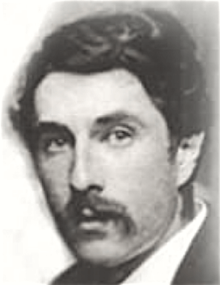
John Paul Cooper [also known as J. Paul Cooper] was born in Leicester, England on 3 October 1869. His birth certificate reveals that he was born John Paul Cooper Loder and that his father's name was John Harris Loder (1832-1906), and his mother's name was Fanny Loder. It is not known when Loder was dropped from family name].
He was articled to the architect John Dando Sedding (1838-1891) in London from 1888 to 1891. In the 1890s he made various alterations to the St. Margaret's Works factory complex owned by his father's textile company Cooper, Corah and Sons Ltd. [later Corah & Sons] in Leicester. He later designed an infants' school and several cottages.
At the advice of Henry Wilson (1864-1934), who had worked as Sedding's assistant, Cooper took up art metalwork and in the late 1890s and set up a workshop at 16 Aubrey Walk, Campden Hill, London. In 1900 he also began making his first jewellery. In 1901 he moved to Birmingham to take up a teaching post in the Metalwork Department of Birmingham Municipal Art School. From 1904 to 1907 he was head of the department.
With the money he inherited following the death of his father in 1906, he was able to give up teaching. With his wife he moved to Kent, where, after living in rented accommodation in Hunton, they moved into a house on Betsom's Hill, near Westerham, Kent. Cooper had designed the house himself and it had a fully-equipped workshop and studio. His wife, May Morgan Oliver (1876-1954), also known as May Cooper, was, like her husband, an art metalworker and jewellery designer. They had worked together since 1899 and had married in 1901.
Cooper's work is characterised by an unconventional use of materials including ostrich egg, coconut shell and shagreen, combined with precious and semi-precious stones, gold, silver and copper. He also took his inspiration from a wide range of forms, from mystical symbolism to mediaeval architecture.
Cooper was one of the key figures in the British Arts and Crafts movement. He was influenced by ideas of William Morris and participated in all the exhibitions of the Arts and Crafts Exhibition Society from 1893 to 1916. In 1908 he became a member of the Art Workers Guild. Between 1902 and 1908 he collaborated with Ernest Gimson (1864-1919) on pieces of art metalwork. Cooper would design and make the pieces at his workshop in Birmingham. They would them be finished and sometimes decorated at Gimson's workshop in Sapperton, Gloucestershire.
Between 1908 and 1915 much of Cooper’s work was sold through the Artificers’ Guild in London. Notable among Cooper's commissions was the Sword of Honour presented to Earl Haig, and a casket for the ashes of the actress Ellen Terry.
In addition to his work as an architect and designer, Cooper was also a watercolour painter. He exhibited at the International Society of Sculptors. Painters and Gravers, the New Gallery, the Royal Miniature Society and Walker's Gallery in London; and the Walker Art Gallery in Liverpool. Cooper died at Betsom's Hill, Kent on 3 May 1933
Armstrong, Barrie and Armstrong, Wendy. The Arts and Crafts movement in the North East of England: a handbook. Wetherby, England: Oblong Creative Ltd., 2013
Armstrong, Barrie and Armstrong, Wendy. The Arts and Crafts movement in the North West of England: a handbook. Wetherby, England: Oblong Creative Ltd., 2006
Birmingham gold & silver 1773-1973. An exhibition celebrating the bicentenary of the Assay Office. Birmingham, England: City Museum and Art Gallery, 1973 [Exhibition catalogue]
Drawings and engravings by Edward Gordon Craig and some silverwork by J. Paul Cooper and Francis Cooper. London: Ifan Fletcher, 1938
Jesse, John and Gere, Charlotte. Jewellery and jewellery design, 1850-1930: & John Paul Cooper, 1869-1933. London: Fine Art Society, 1975
Karlin, Elyse Zorn. Jewelry & Metalwork in the Arts & Crafts tradition. Atglen, Pennsylvania: Schiffer Publishing, 2nd revised edition, 2004
Kuzmanovic, N. Natasha. John Paul Cooper: designer and craftsman of the Arts and Crafts movement. Stroud, Gloucestershire, England: Sutton, 1999 [ISBN 0750920882)
Kuzmanovic, N. Natasha. John Paul Cooper (1869-1933), designer and craftsman. Ph.D. thesis, University of Michigan, 1995